Martin P.M. Handbook of Deposition Technologies for Films and Coatings, Third Edition: Science, Applications and Technology
Подождите немного. Документ загружается.


Characterization of Thin Films and Coatings 811
beams. Sample topography differences, and orientation of individual polycrystalline or
nanocrystalline grains, are expected to strongly affect the imaging contrast. The crystalline
surface which is aligned with the direction of ion beam is expected to be channeled by the ion
beam and produce low backscattered electrons as opposed to other polycrystalline
orientations. Therefore channeled crystal will appear much lighter than surrounding darker
grains, if the surrounding grains are oriented in the off-normal axis with respect to the
incoming ion beam channeling direction. By using ion beam-induced imaging in conjunction
with conventional secondary electron imaging, one can make interpretations about the
microstructure and grain-boundary formation mechanisms in any polycrystalline sample. This
effect is even more magnified when elements with a high Z value are involved in the analysis.
Strengths:
3D analysis.
High phase contrast ion imaging.
Selected area sample preparation and extraction.
Limitations:
Requires vacuum.
Damages the sample.
Ga deposition and induced damage.
16.4.5 Sputter Depth Profiles and Sample Thickness Measurements
M.H. Engelhard
In many circumstances, it is important to obtain information about the elemental or molecular
distribution of components within a film. It can also be essential to know the thickness of a
film or the layers within a film. Sputter depth profiling can be a useful way to address both
these requirements. In this section, information is provided both about sputter depth profiling
and some methods to determine film thickness. The depth profiling section provides some
general background and information about some of the more recent advances and new
directions in sputter profiling.
16.4.5.1 Composition Profiles
It is often important to understand the composition profiles of thin films or coatings as they are
synthesized, as they age, or when failure occurs. Depending on the thickness and required
resolution, a variety of destructive or non-destructive approaches can be used. Ion-induced
sputter depth profiling has been found to be very useful for many different applications.
Sputter depth profiling has been well reviewed, including several useful reviews by Hofmann

812 Chapter 16
Table 16.5: Typical ions used in common sputter depth profiling methods, with suitable
ion energy ranges
Method Typical ions
used
Typical ion
energies(keV)
Comments
TOF-SIMS Cs
+
0.2–10 Detect material removed
O
2
+
0.2–10
C
60
+
/C
60
2+
5–40
Dynamic SIMS Cs
+
/O
2
+
0.5–20 Detect material removed
GDMS Ar
+
0.3–5 Detect material removed
AES Ar
+
0.5–5 Detect material remaining on surface
XPS Ar
+
0.5–5 Detect material remaining on surface
(some C
60
+
)
[110, 111] that examine both general considerations about general aspects of profiling and the
methods for obtaining information about interfaces. Sputter profiling can be done by several
different methods, including AES, SIMS, XPS, and GDMS. As shown in Table 16.5, there are
both similarities and differences among these methods. As highlighted by Hofmann [111],
some methods examine material removed from the samples (SIMS and GDMS) while other
methods examine material remaining on the surface (AES and XPS). A few factors important
to ion sputtering depth profiling are noted below:
Beam energy, angle of incidence, flatness of the sample, sample rotation, and other
conditions significantly impact the rate and overall quality of sputter depth profiles
[112, 113]. An example of the impact of sample rotation on resolution of the depth
profile of a multilayer NiCr sample is shown in Figure 16.40.
Higher beam energies usually produce faster sputter rates, but have decreased
interfacial resolution.
AES and SIMS are known as the methods for which sputter profiling has been very
common. The development of higher spatial resolution XPS capability has allowed
increased use of XPS for sputter depth profiling.
Many factors influence the interfacial resolution. These include all of the factors listed
above for depth profile quality, plus (for XPS and AES) the kinetic energy of the
electrons used for elemental analysis. Lower kinetic energy electrons have shorter
IMFP and allow increased interfacial resolution [113].
Among the recent developments in ion sputtering is the increased use of cluster ion
beams (C
60
+
,SF
5
+
, etc.) [114, 115]. They are especially useful for depth profiling of
organic materials, biological tissues, and polymer materials. As an example, the
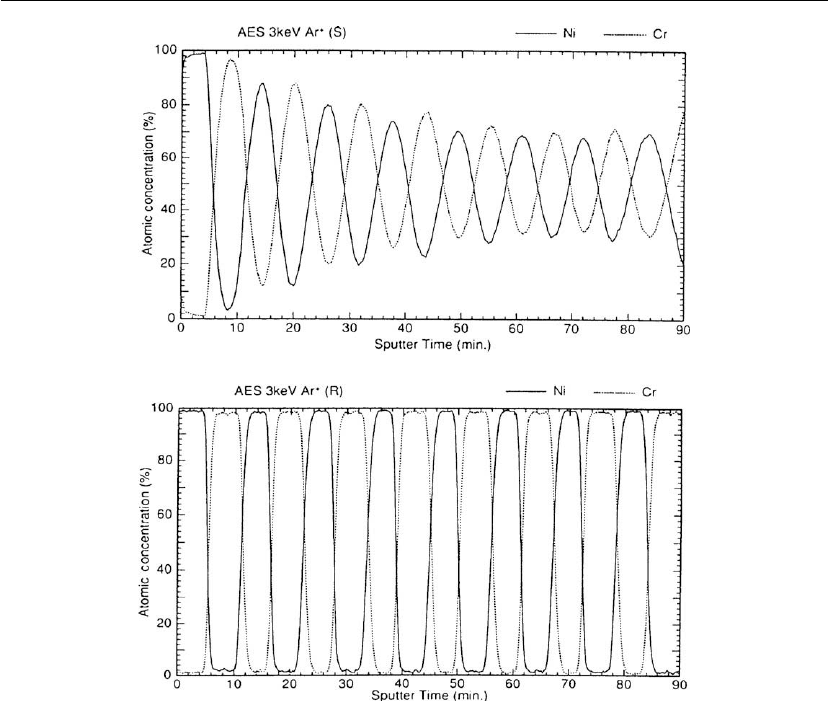
Characterization of Thin Films and Coatings 813
Figure 16.40: Auger electron spectroscopy sputter depth profiles of a NiCr multilayer film (30 nm
layers) generated using 3 kV Ar
+
beam with and without sample rotation. The data show that
rotation can significantly improve the depth resolution and allow high-quality data to be collected
from the sample [113].
differences between Ar
+
and C
60
+
sputtering and XPS analysis of plasma-treated
ethylene-tetrafluoroethylene-copolymer (ETFE) [116] are highlighted in Figure 16.41.
There is little apparent damage with the C
60
+
sputtering and almost immediate damage
with the Ar
+
. In addition, TOF-SIMS experiments shows that molecular information
can be preserved after C
60
+
sputtering in the ice matrix or trahelose matrix [117, 118].
It should be noted, however, that C
60
+
or any form of cluster sputtering does not work
ideally in all circumstances and that the impact of sputtering by many types of cluster
is subject to a good deal of current research [119]. Seah [120] has proposed a
framework for understanding the yield dependence of cluster sputtering depending on
the ion mass and atomic number. Mahoney and co-workers [121] have examined the
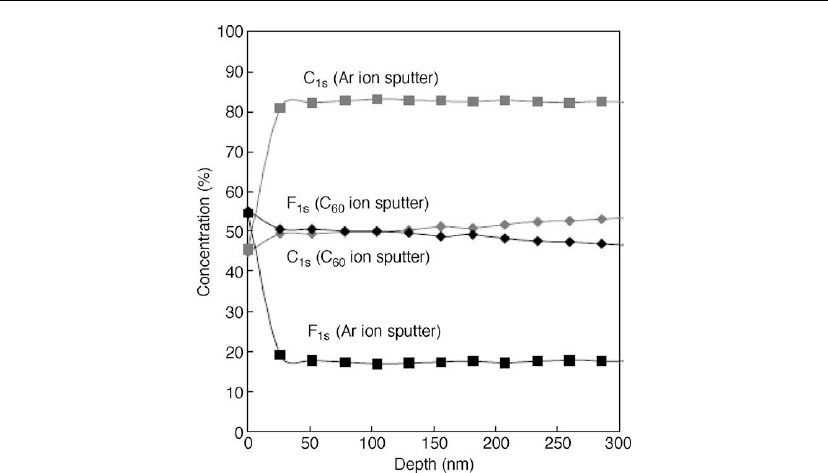
814 Chapter 16
Figure 16.41: XPS sputter profiles generated using Ar
+
and C
60
sputtering of plasma-treated
ethylene-tetrafluoroethylene-copolymer (ETFE). Note that there is a rapid variation in the F and C
signals for Ar
+
, while the C
60
ion sputtering is more consistent with expected composition of
ETFE [116].
temperature dependence of damage, while Yu et al. [122] suggest that a combination of
C
60
+
and Ar
+
sputtering can extend the useful range for sputter profiling organic films.
16.4.5.2 Film Thickness
Many different methods can be used to determine film thickness. The importance of the
different methods will vary with the nature and thickness of the films and general comments
may not apply in all circumstances. However, some of the common methods to determine
thickness are listed in Table 16.6 along with the nominal thickness ranges where they most
commonly apply. Some of the issues or concerns related to applying the methods are
noted. It is important to realize that some methods require a vacuum and some are
destructive.
Particularly for ultrathin films, which are of increasing importance for some electronic
materials and other applications, there has been significant work conducted considering the
advantages, limitations, and overall consistency of the various thickness measurement
methods [123]. It seems particularly important to note that there are apparently some small but
systematic offsets among the different measurement methods that fundamentally relate to what

Characterization of Thin Films and Coatings 815
Table 16.6: Nominal thickness ranges for different techniques
Technique Nominal thickness
range
Comments
Ion sputter profile – XPS 3 nm < d < m Composition and thickness,
destructive
Ion sputter profile – AES 3 nm < d < m Composition and thickness,
destructive
Ion sputter profile – static SIMS 3 nm < d < m Composition, thickness, dopant
profiles, destructive
Ion sputter profile – dynamic SIMS 3 nm < d < m Composition, thickness, dopant
profiles, destructive
Angle resolved XPS d < ∼10 nm Composition, thickness,
non-destructive, model dependent,
requires flat samples
Peak to background XPS d < ∼10 nm Composition, thickness,
non-destructive, model dependent
TEM 1nm<d < ∼m Based on cr oss-section
RBS 0.1 nm < d < ∼1 m Best for heavy elements on light
substrate
NRA – resonant 8 nm < d <3m H-NRA
NRA – non-resonant 50 nm < d <3m
ERDA 0.1 nm < d < 500 nm H ERDA and heavy ion ERDA
MEIS 0.1 nm < d < 0.2 m
GDMS 0.5 m<t <10m Trace element sensitivity
XRR 5nm<t < ∼100 nm Thickness and roughness
information
Stylus profilometer 50 nm < t < 500 m Measures height variations, needs
appropriate edge to determine
thickness; provide measure of
roughness; stylus usually
non-destructive, but varies with
material
Optical profilometer 50 nm < t < 500 m Opaque sample requir ement,
needs edge to determine thickness,
Estimated roughness analysis,
non-destructive

816 Chapter 16
is being measured and how the measurement is understood [124]. Especially for very thin
films, knowing about such differences can be important in obtaining a consistent
understanding of films.
Strengths:
Quantitative depth profiles.
Accurate film thickness measurements.
Limitations:
Requires vacuum.
Extensive sample damage.
16.5 Incident Electron Methods
Methods involving incident electrons include Auger electron spectroscopy (AES), scanning
electron microscopy (SEM), energy dispersive X-ray spectroscopy (EDXS), transmission
electron microscopy (TEM), and electron diffraction (low-energy electron diffraction (LEED)
and reflection high-energy electron diffraction (RHEED)).
16.5.1 Auger Electron Spectroscopy
A.S. Lea
Because of its ability to focus an electron beam, AES has the highest spatial resolution of any
conventional surface analysis tool. AES has been highly important for electronic materials,
analysis of particles and grain boundaries, and for use in obtaining sputter profiles of many
types of materials. AES relies on the Auger process to probe the elemental composition of the
outermost layers of surfaces. First discovered by Auger and Meitner in the 1920s, the Auger
process results from an energetic electron or photon, typically 2–20 keV, stimulating the atom
by creating a hole in a core shell through ejection of an ionizing electron [125, 126]. The atom
relaxes when an outer shell electron drops down to fill the core level hole and the excess
energy is then released by one of two competing processes: through the release of a photon or
the release of a third outer shell electron, the so-called Auger electron. Since electron shell
energy levels are unique to each atom, the energy of this Auger electron is characteristic of the
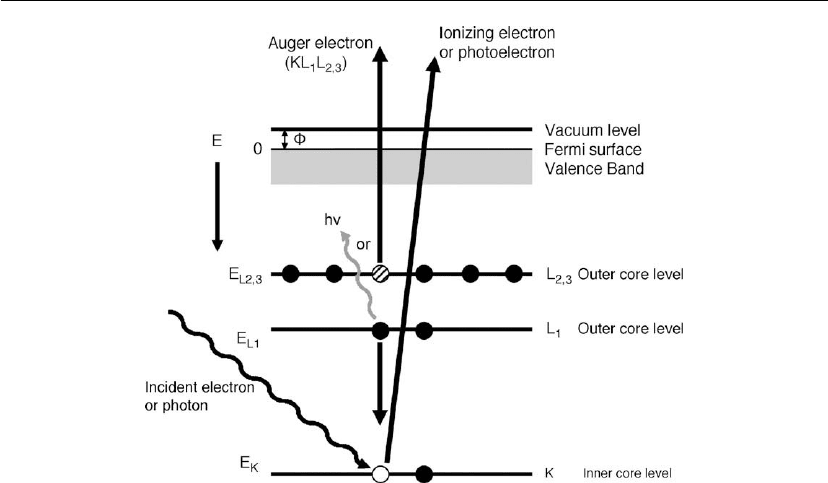
Characterization of Thin Films and Coatings 817
Figure 16.42: Schematic of the Auger process showing that a core shell vacancy in the K level is
filled by an electron from a higher energy level and a third electron, the Auger electron, is emitted.
atom from which it originated and depends on the electronic transitions involved. For the
process involving the energy levels depicted in Figure 16.42, the kinetic energy of the Auger
electron is given by Eq. (16.6):
E
KL
1
L
2,3
= E
K
− E
L
1
− E
L
2,3
− φ (16.6)
where E
K
is the energy of the ionized core-level electron, E
L
1
is the energy of the outer level
electron that drops down to fill the hole, E
L
2,3
is the energy level of the Auger electron, and φ is
the spectrometer work function, i.e., the energy necessary to promote an electron from the
Fermi level to the vacuum level.
While it may appear that a plethora of transitions are possible yielding numerous Auger
transitions in the energy spectrum, particularly for high Z elements, only a few occur with
sufficient probability that they are visible in the Auger spectra. This minimizes the appearance
of overlapping peaks and makes AES spectra relatively easy to interpret. This is due to both
the electron-impact cross-section (how easily core holes are created) and the Auger and
fluorescence yields. The energy level of the core hole often determines the transitions that will
be favored. For a K shell hole, transitions can occur from the L levels, producing strong KLL
peaks in the energy spectrum. Higher level transitions, such as those from M levels, may also
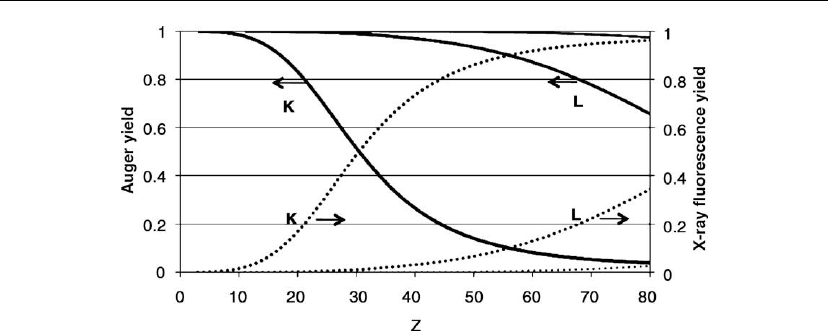
818 Chapter 16
Figure 16.43: Plot of Auger electron emission (solid lines) and X-ray fluorescence (dashed lines)
yields as a function of atomic number (Z) for each core shell vacancy using data from Hubbell
et al. [127]. AES has good sensitivity for low Z elements.
occur, but are much less likely to do so. The strongest electron–electron interactions are
between levels that are close in energy, and this gives rise to the characteristic KLL, LMM,
MNN peaks seen in Auger spectra. The probabilities of Auger yield and fluorescence (X-ray)
yield for the various transitions are shown in Figure 16.43 [127]. In the case of a K shell hole,
the Auger yield is highest for low Z elements, whereas the fluorescence yield is greater for the
high Z elements and so AES is much more sensitive to low Z elements than electron probe
microanalysis.
The surface sensitivity of AES, as well as the other electron spectroscopies, is due to the low
IMFP of electrons. Auger electrons, with kinetic energies ranging from about 30 to 2500 eV,
have material-dependent IMFPs (λ) ranging from about 0.2–2 nm. The information depth for
AES is ∼3λ and so the Auger peaks visible in the spectra originate from only 0.5–5 nm
beneath the surface. While the energetic primary beam can penetrate micrometers below the
surface, those Auger electrons that originate at depths below the information depth lose their
characteristic energy owing to inelastic collisions and contribute to the background observed
in AES spectra. The low IMFP also necessitates the use of ultrahigh vacuum conditions to
minimize scattering off residual gas atoms and has the additional benefit of keeping the surface
clean from adsorbates that may collect on the surface at higher pressures.
The highly energetic incident electron beam penetrates deep into the sample and initiates an
electron cascade, whereby inelastic collision of the primary electrons with surrounding atoms
causes these electrons to lose a portion of the primary energy. The energy transfer can also
propagate additional electrons through ionization of atoms within the substrate. These
mechanisms contribute to the broad featureless background observed in the Auger spectra.
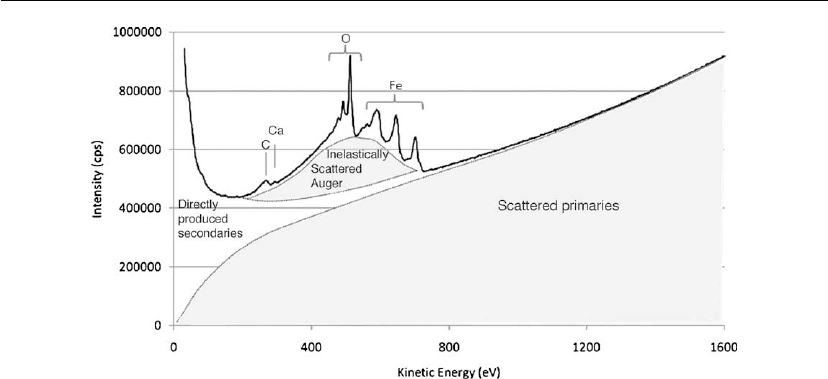
Characterization of Thin Films and Coatings 819
Figure 16.44: Raw Auger spectrum of a natural hematite sample. Shown in the figure are the
Auger peaks on top of a large background that must be removed for accurate quantification.
Low-energy electrons emitted from the surface are designated as secondary electrons and are
captured by the secondary electron detector, allowing one to obtain SEM images of the surface
at high resolution during the AES analysis.
Figure 16.44 shows a plot of a typical Auger spectrum with the Auger peaks superimposed on
top of a large background of backscattered primaries, inelastically scattered Auger electrons,
and secondary electrons. This large background, while easily removed through differentiation,
still limits the sensitivity that can be achieved with this technique.
As seen from Eq. (16.6), the kinetic energy of the Auger electron is independent of the energy
of the incident radiation. It is only necessary to impart sufficient energy to the atom to generate
an electron hole in a core-level shell. The probability with which this occurs is greatest when
the energy of the incident radiation is two to three times the energy of the core shell and so the
Auger process is most efficient when the incident radiation is 2–20 keV. Whereas it is possible
to utilize either photons or electrons to initiate the process, electron beams are used in most
instruments since they are more easily focused than X-rays and can provide higher spatial
resolution [128]. While both LaB
6
filaments and field emitters are high-current sources
utilized in Auger spectrometers, newer generation instrumentation are migrating towards field
emission electron guns through which beam sizes below 20 nm are now achievable. This small
beam size combined with the short IMFP provides AES with the smallest analytical volume of
any standard surface analysis equipment.
The schematic of a typical Auger spectrometer is depicted in Figure 16.45. In this set-up,
electron optics focus the electrons generated from either a field emission source or an LaB
6
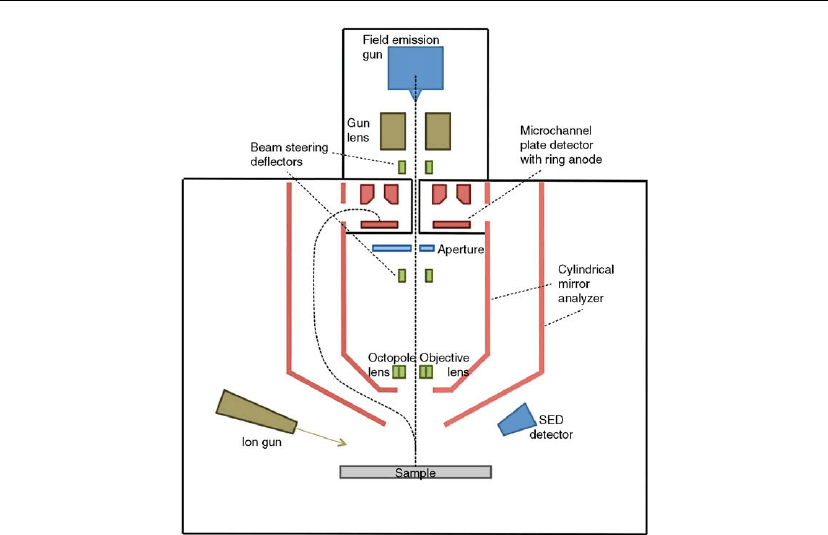
820 Chapter 16
Figure 16.45: Schematic diagram of an Auger spectrometer including the electron gun, focusing
lenses, sample, and cylindrical mirror electron analyzer.
filament onto the sample. Electrons produced from the sample enter the coaxial cylindrical
mirror analyzer (CMA) and are focused into the electron multiplier and detector. The voltage
on the outside plates of the CMA is swept such that at any given time, only electrons that fall
within a narrow energy window are able to reach the detector. In this manner, the spectrometer
can scan the energy spectrum and measure the intensity of incident electrons as a function of
their kinetic energy. The spectrometer is often equipped with an ion source for depth profiling
experiments, and in the case of newer generation instruments, charge neutralization. Most
spectrometers are also equipped with a secondary electron detector which permits acquisition
of high-resolution SEM images of the surface during AES analysis.
As alluded to earlier, the Auger peaks visible in an intensity versus energy [N(E)vsE]
spectrum sit on top of a large background of backscattered primary electrons, secondary
electrons, and inelastically scattered Auger electrons, and are typically only a small percentage
of the total electrons that reach the electron detector. In order to perform quantitative analysis,
it is necessary to derivatize the spectrum [d(N(E))/dE vs E] to remove the background and
utilize the intensity of the derivatized Auger peaks in the quantification. The underlying
equation for quantification is given by Eq. (16.7):
Atomic concentration of element i = (I
i
/RSF
i
)×100/(
i
I/RSF) (16.7)
